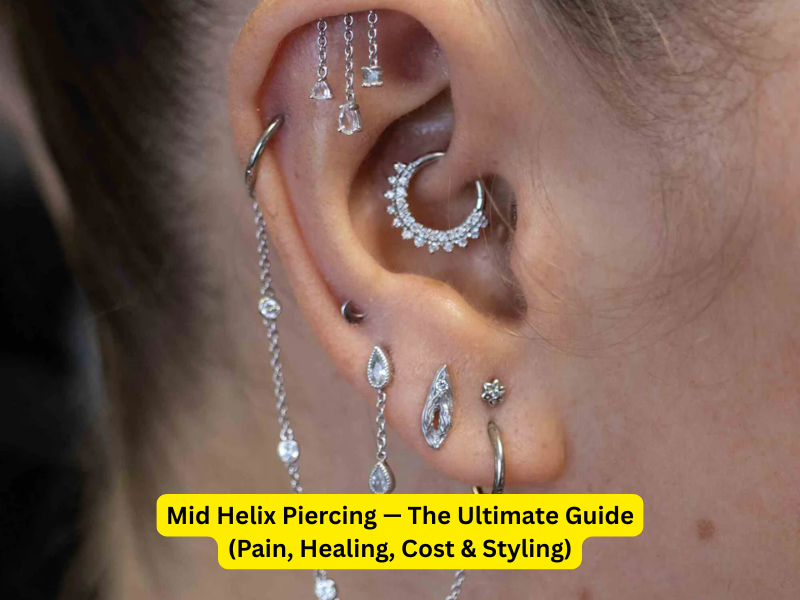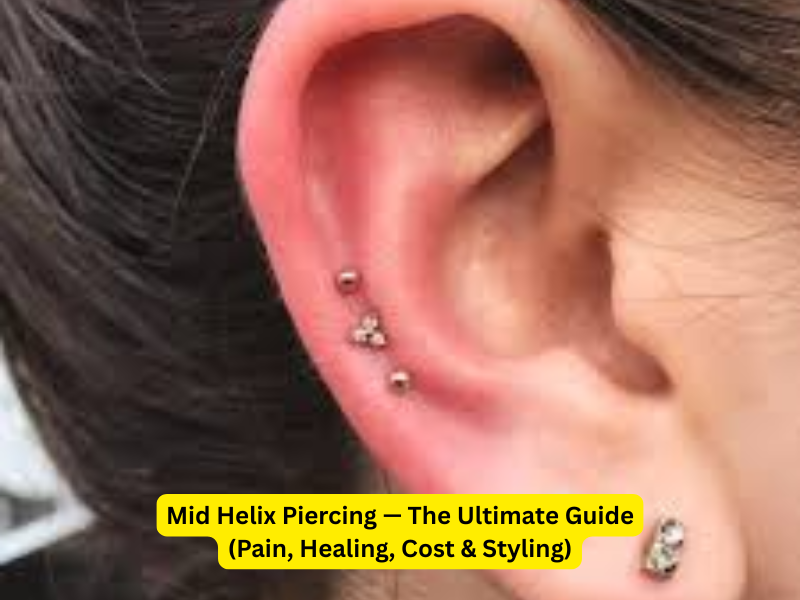Have you noticed how ear piercings are no longer just about the lobes? People are building entire curated ear stacks, mixing studs, hoops, and chains like little ear parties. Right in the middle of all this ear bling sits the mid helix piercing — subtle, stylish, and versatile.
It’s becoming one of the most requested cartilage piercings because it sits at the sweet spot between “understated” and “statement-making.” But before you book an appointment, you probably want to know: What exactly is it? Does it hurt? How much does it cost? And how do you care for it?
Let’s dive into everything you need to know about the mid helix piercing.
Table of Contents
What Is a Mid Helix Piercing?
Ear Anatomy Explained
Your ear helix is the outer rim of cartilage that curves from the top down toward the lobe. A mid helix piercing is placed right in the middle section of that rim — not too high like an upper helix, and not too close to the face like a forward helix.
Think of your ear rim like a road: the mid helix is that comfortable stretch right in the middle.
Mid Helix vs. Upper Helix vs. Forward Helix
-
Upper Helix: At the very top curve of the ear.
-
Forward Helix: Near the front of the ear, close to your temple.
-
Mid Helix: Right in between — balanced, centered, and versatile.
Placement Options and Variations

Single Mid Helix
A simple single stud or hoop through the mid helix looks classy and minimal.
Double or Stacked Mid Helix
If you want a more curated ear look, you can get two or three mid helix piercings stacked vertically. It gives a layered, fashionable vibe — especially with dainty hoops.
Jewelry Choices for Mid Helix Piercings
Studs and Flatbacks
A flat-backed stud is the go-to starter jewelry. It’s comfortable, doesn’t snag easily, and puts less pressure on the piercing while healing.
Hoops and Seamless Rings
Once healed, hoops give that iconic mid helix look — from tiny seamless rings to decorative hoops with gems or chains.
Best Materials for Healing
Your jewelry material matters just as much as the style. The safest choices are:
-
Implant-grade titanium (lightweight, hypoallergenic)
-
Niobium (another hypoallergenic option)
-
14k or 18k solid gold (luxurious but safe if nickel-free)
Avoid cheap alloys or plated jewelry — they often irritate cartilage piercings.
The Piercing Procedure — What to Expect
Consultation and Marking
Before anything sharp comes near your ear, your piercer will:
-
Check your ear shape
-
Discuss placement
-
Mark the exact spot with a sterile pen
-
Get your approval
Step-by-Step Piercing Process
-
The area is disinfected.
-
A sterilized hollow needle is used (never a gun).
-
Jewelry is inserted immediately after.
-
The area is cleaned again.
Why Needles Are Safer Than Guns
Piercing guns crush cartilage, which can cause infections, scarring, and longer healing times. A hollow needle creates a precise hole, causing less trauma. Always choose a piercer who uses needles.
Does a Mid Helix Piercing Hurt?

Pain Levels Compared to Other Cartilage Piercings
Pain is subjective, but most people rate a mid helix piercing as 3–5 out of 10. It’s more painful than a lobe but less intense than thicker cartilage piercings like the conch.
Expect a sharp pinch followed by mild throbbing for a few hours.
Tips for Managing Discomfort
-
Take a deep breath before the piercing.
-
Use a cold compress to reduce swelling.
-
Sleep on the opposite side for a few weeks.
-
Avoid fiddling with the jewelry.
Healing Process & Timeline
Average Healing Time
A mid helix piercing usually takes 6–9 months to fully heal. Some lucky people heal in 3–4 months, but others need up to a year.
Factors That Affect Healing
-
Jewelry quality
-
Aftercare routine
-
Sleep habits (side sleeping slows healing)
-
Immune system health
-
Avoiding trauma (snagging on hair, headphones, hats)
Aftercare Routine
Cleaning Methods (Saline Spray, Soaks)
-
Use sterile saline spray twice daily.
-
Or soak with a sea salt solution (1/4 tsp salt in 1 cup distilled water).
-
Pat dry with a clean tissue — never twist the jewelry.
What to Avoid During Healing
-
No alcohol, hydrogen peroxide, or harsh antiseptics.
-
Avoid touching with dirty hands.
-
Skip swimming pools, hot tubs, and lakes for the first 2–3 months.
Sleeping, Headphones, and Sports Tips
-
Use a travel pillow to keep pressure off the piercing at night.
-
Avoid over-ear headphones for at least a month.
-
Tie back long hair during sports to avoid snags.
Common Problems & Solutions
Infections and Irritation Bumps
Mild redness and clear discharge are normal. But yellow/green pus, severe swelling, or fever? That’s an infection — see a doctor.
Irritation bumps (tiny raised bumps near the piercing) usually come from friction, poor jewelry, or touching. Switch to titanium and avoid trauma.
Keloids and Scarring Issues
Some people are prone to keloids (large raised scars). If you notice abnormal growth, consult a dermatologist early.
Cost of a Mid Helix Piercing
Average Price Range
A mid helix piercing typically costs $40–$80, depending on the studio. Jewelry upgrades can push the total to $100–$200.
Factors Influencing Cost
-
Studio reputation
-
Piercer experience
-
Jewelry material (gold vs. titanium)
-
City or country you’re in
How to Choose the Right Piercer
Studio Hygiene and Certifications
Look for:
-
Autoclave sterilization
-
Single-use needles
-
Certified piercers
-
Clean, professional environment
Questions to Ask Before Piercing
-
“What jewelry material do you use?”
-
“Do you provide aftercare instructions?”
-
“How many mid helix piercings have you done?”
Styling Inspiration
Pairing with Lobe and Conch Piercings
Mid helix piercings look amazing stacked above simple lobe studs or paired with a conch hoop for balance.
Minimalist vs. Statement Jewelry Looks
-
Minimalist: Tiny titanium stud or dainty hoop.
-
Statement: Gemmed hoops, chains, or stacked mid helix piercings.
Pros and Cons of Getting a Mid Helix Piercing
Pros:
-
Stylish and versatile
-
Works with both studs and hoops
-
Fits well in curated ear stacks
Cons:
-
Longer healing than lobe piercings
-
Can be painful to sleep on
-
Risk of irritation bumps or keloids
Final Tips for First-Timers
-
Don’t cheap out on jewelry — titanium or gold only.
-
Follow aftercare instructions religiously.
-
Be patient — cartilage piercings take time.
-
Book with a professional piercer, not a mall kiosk.
Conclusion — Is the Mid Helix Piercing Right for You?
The mid helix piercing is the perfect mix of edgy and elegant. It’s not as bold as a conch, not as subtle as a lobe — it’s right in the middle, literally and style-wise.
Yes, it takes patience to heal and costs a bit more than a standard lobe piercing. But with the right piercer, jewelry, and aftercare, you’ll end up with gorgeous Double Lobe Piercing Earrings that level up your style game.
If you want a piercing that’s versatile, modern, and totally Instagram-worthy, the mid helix piercing is calling your name.
Frequently Asked Questions (FAQs)
Q1: How painful is a mid helix piercing?
A1: Most people rate it around 3–5/10. It’s a quick pinch with some soreness afterward, but not unbearable.
Q2: Can I wear hoops right away?
A2: No. Hoops can move and irritate the piercing. Start with a stud, then switch to hoops after 6–9 months.
Q3: How long before I can change jewelry?
A3: Wait at least 4–6 months, but ideally after full healing (up to 9 months). Always ask your piercer first.
Q4: What side of the ear should I pierce?
A4: Totally up to you! Some people match with other piercings, others balance by piercing the opposite side.
Q5: Is mid helix suitable for everyone?
A5: Most people can get it, but if you have very thin or irregular cartilage, your piercer may suggest a different placement.

